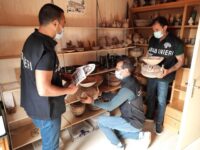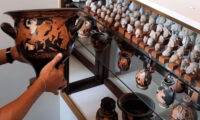 The Italian Carabinieri Art Squad in collaboration with European authorities has confiscated almost 800 ancient southern Italian artifacts from the home of an unnamed wealthy collector in a town near Antwerp. The 782 archaeological objects were all illegally excavated from the region of Puglia. They date to between the 6th century B.C. and the 3rd century B.C. and are worth an estimated $13 million, if their immense archaeological value could ever be assessed in market terms.
The Italian Carabinieri Art Squad in collaboration with European authorities has confiscated almost 800 ancient southern Italian artifacts from the home of an unnamed wealthy collector in a town near Antwerp. The 782 archaeological objects were all illegally excavated from the region of Puglia. They date to between the 6th century B.C. and the 3rd century B.C. and are worth an estimated $13 million, if their immense archaeological value could ever be assessed in market terms.
This bust was the result of three years of investigation, and it all started thanks to an eagle-eyed conservator. In 2017, a conservator at the restoration laboratory for the Archaeological Superintendency of the Foggia area spotted a stele of the Daunian civilization published in the catalogue of a 1993 exhibition of ancient Italic art at the Rath Museum in Geneva. The stele was missing a central area. The incised design at the margins of the gap completed the design of a mounted warrior on a fragment of a stele in the Archaeological Museum of Trinitapoli.
The Daunian people inhabited the north of Apulia in the 1st millennium B.C., one of three tribes that grew from the union of Illyrian and Mycenean Greek settlers in the region. The Daunians assimilated less with the indigenous Italic peoples than the other two tribes and developed characteristic monuments and pottery unique to them. Of particular note are their funerary steles, made between the late 8th century B.C. and the 6th century B.C. and incised with elaborate decorations representing the deceased. No two are alike and they are very much peculiar to the Foggia-Barletta area that was the epicenter of Daunian culture.
So when the stele in the catalogue picture seemed to be an exact fit for a fragment in the museum, Italian authorities reached out to INTERPOL to find out who this Belgian owner was. His identity determined, the next step was securing a warrant to search his property and recover any other funerary artifacts looted from Apulian tombs.
 The stele was found in his possession and it matched the fragment exactly, but that was just the tip of the iceberg. Police confiscated an unprecedented quality of Apulian objects: red-figure, black-figure pottery and geometric pottery both Attic and local, Daunian steles, Greek terracotta figurines, clay heads, winged statuettes. Apulian works with anything like a legal ownership record are vanishingly rare and even the few in major institutions around the world can only be traced to the 1990s, so a full museum secreted in one guy’s house in Antwerp can only have been secured through years of dedicated traffic in looted archaeological objects. He didn’t just amass this number of high-quality Apulian artifacts in excellent condition by browsing flea markets and antique shops.
The stele was found in his possession and it matched the fragment exactly, but that was just the tip of the iceberg. Police confiscated an unprecedented quality of Apulian objects: red-figure, black-figure pottery and geometric pottery both Attic and local, Daunian steles, Greek terracotta figurines, clay heads, winged statuettes. Apulian works with anything like a legal ownership record are vanishingly rare and even the few in major institutions around the world can only be traced to the 1990s, so a full museum secreted in one guy’s house in Antwerp can only have been secured through years of dedicated traffic in looted archaeological objects. He didn’t just amass this number of high-quality Apulian artifacts in excellent condition by browsing flea markets and antique shops.
He, of course, contested the seizure of his looted antiquities, but all of his appeals have failed and the collection has now been transferred to Italy where archaeologists will study and document it thoroughly.
King Daunus (Δαῦνος), King of the Daunians, begged Diomedes for help in warring against the Messapians for a share of the land and marriage to his daughter. Diomedes agreed to the proposal, drew up his men and routed the Messapians.
Apulian tribes were the Peucetians, the Daunians and the Messapians. Diomedes is one of the main characters in the Iliad. Herodotus, however, does not seem to mention the Daunians or Daunus, but he mentions the Messapians in Bk.7.170.
:hattip:
————-
“..For the story goes that Minos, having come to Sicania, which is now called Sicily, in search of Daidalos, died there by a violent death; and after a time the Cretans, urged thereto by a god, all except the men of Polichne and Praisos, came with a great armament to Sicania and besieged for seven years the city of Camicos [Camastra, Sicily?], which in my time was occupied by the Agrigentines; and at last not being able either to capture it or to remain before it, because they were hard pressed by famine, they departed and went away. And when, as they sailed, they came to be off the coast of Iapygia [“Apulia”], a great storm seized them and cast them away upon the coast; and their vessels being dashed to pieces, they, since they saw no longer any way of coming to Crete, founded there the city of Hyria [east of Nuceria Altaferna?]; and there they stayed and were changed so that they became instead of Cretans, Messapians of Iapygia, and instead of islanders, dwellers on the mainland: then from the city of Hyria they founded those other settlements which the Tarentines long afterwards endeavoured to destroy and suffer great disaster in that enterprise, so that this in fact proved to be the greatest slaughter of Hellenes that is known to us, and not only of the Tarentines themselves but of those citizens of Rhegion [Reggio Calabria] who were compelled by Mikythos the son of Choiros to go to the assistance of the Tarentines, and of whom there were slain in this manner three thousand men: of the Tarentines themselves however, who were slain there, there was no numbering made. This Mikythos, who was a servant of Anaxilaos, had been left by him in charge of Rhegion; and he it was who after being driven out of Rhegion took up his abode at Tegea of the Arcadians and dedicated those many statues at Olympia.”
————-